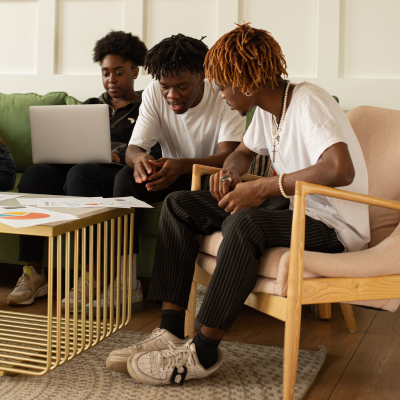How to Build a Connection: 19 Tried-and-Tested Tips
Time after time, studies have shown that meaningful relationships are the best predictor of a happy life. So you’re wise to proactively seek information about how to build a connection, and we are excited to have you here. Helping people cultivate meaningful connections is the whole reason why my sister and I created So Syncd—you’d be hard-pressed to find two people more passionate about the topic.

Time after time, studies have shown that meaningful relationships are the best predictor of a happy life. So you’re wise to proactively seek information about how to build a connection, and we are excited to have you here. Helping people cultivate meaningful connections is the whole reason why my sister and I created So Syncd—you’d be hard-pressed to find two people more passionate about the topic.
Many people spend their lives chasing the next shiny reward—a new car, a bigger house, or a higher salary—but the most enduring happiness will come from your relationships. It’s a little crazy when you think about it.
Most of us want to be happy. Yet, ironically, very few people consciously focus on what truly matters: building long-lasting, meaningful connections. Equally, few people reflect on the state of the relationships in their lives.
If you asked the average person on the street what would bring them the most happiness, they would likely say money or material possessions rather than making new friends or spending more time with the people they already know. But science tells us that our relationships are the main drivers of our overall happiness.
How connections impact our well-being
Not only do social connections and a sense of belonging have a positive impact on our mental health, but also our physical health. Strong social support networks have been associated with better well-being, lower rates of depression, reduced stress levels, and an overall increased sense of satisfaction with life.
- – A ten-year study published in PLOS ONE in 2013 discovered that the risk of depression was significantly greater among those with baseline social strain, lack of social support, and poor overall relationship quality. Those with the lowest overall quality of social relationships had more than double the risk of depression.
- – A study published in The Journals of Gerontology in 2018 showed that social isolation was associated with a 50% increased risk of dementia.
- – A study published in the Proceedings of the National Academy of Sciences in 2016 found that human connections can impact immune system functioning. The researchers discovered that weak social relationships were associated with increased inflammation and decreased immune response.
- – A study published in the journal Heart in 2016 found that poor social relationships were associated with a 29% increase in the risk of incident coronary heart disease and a 32% increase in the risk of stroke.
- – A meta-analysis published in PLOS Medicine in 2010 examined data from over 300,000 participants and concluded that individuals with strong social relationships had a 50% increased likelihood of survival compared to those with weaker social connections.
So, the evidence is clear: relationships matter. Without meaningful connections, our physical and mental health will suffer. Even the most introverted among us should need deep connections to thrive. At the end of the day, we are social creatures who have evolved to be part of a community and to strive for a sense of belonging.
19 tried-and-tested tips for how to build a connection
Now we have established the importance of relationships, let’s look at 19 tried-and-tested tips for building a connection.
1. Active listening.
Actively listening involves paying full attention to someone when they are speaking and fully absorbing their words. It is vital for building a connection because it demonstrates respect, empathy, and interest. By showing that you’re present and fully engaged in the conversation, you demonstrate that you value their thoughts and feelings, which makes people feel understood and appreciated.
If someone senses that you are truly listening to them, they will be much more likely to open up and share their inner world with you. Have you ever been talking to someone and noticed they weren’t paying attention? You probably felt disrespected and unimportant. Not only does active listening let the person know that you value them and their ideas, but it also allows you to learn from them. Furthermore, active listening helps avoid misunderstandings, especially when you clarify your understanding of what has been said, ensuring that both parties are on the same page. This can cultivate a healthier and more effective communication dynamic and indicate a willingness to invest effort into ensuring that you understand the message they are trying to convey.
Last but not least, active listening enables us to truly get to know someone. It helps us to understand how they think, feel, and act. Understanding their needs, values, opinions, and beliefs is essential for building a strong connection.
2. Empathy.
Empathizing is about putting yourself in someone else’s shoes in order to understand their perspective and feelings. Empathy is fundamental for building a connection because it demonstrates that you are genuinely invested in the other person and their wellbeing. When you show empathy, you demonstrate that you care, and people take comfort in knowing that you understand what they are going through, particularly during challenging times.
When you empathize with someone, you aren’t just acknowledging their experiences but also validating their emotions, which makes them feel heard and understood. This can cultivate trust, openness, and deeper intimacy. Furthermore, empathy shows compassion and kindness—highly valued qualities in any relationship.
Empathy also enables us to better navigate conflicts and disagreements in a more understanding and respectful manner. This can enable us to understand the other person’s perspective better and reach a middle ground by encouraging compromise and collaboration.
3. Show appreciation.
Showing appreciation is essentially expressing gratitude and acknowledging someone’s efforts or contributions. The reason it’s important for building a connection is because it conveys recognition and validation of someone’s value. This can make them feel respected and appreciated. Think about it: would you want to invest in a relationship with someone who didn’t care about or recognize what you bring to the table? Probably not.
When someone fails to see our positive qualities, it can lead to feelings of inadequacy and even resentment. It’s not about expecting something in return—it’s about demonstrating to someone that you notice and appreciate their strengths and contributions. It could be as simple as “You did such a great job on this project” or “I’m so grateful for your support.” This type of acknowledgment goes a long way in fostering an emotional connection.
If someone knows that you don’t take your presence or actions for granted, it can make them feel more secure and valued in the relationship. Ultimately, showing appreciation communicates love, respect, and admiration, all of which are key to building a meaningful and lasting connection.
4. Be authentic.
Being authentic means being true to yourself and letting your personality shine through. It is essential for building a connection because it allows both parties to understand and appreciate each other for who they truly are. When you’re authentic, you’re honest about your thoughts, feelings, and experiences, cultivating trust in a relationship. This honesty can lead to deeper conversations and shared understanding, enhancing an emotional bond.
Authenticity also shows that you’re comfortable with who you are, displaying confidence, which is a universally attractive quality. Furthermore, being authentic means staying true to your values and beliefs, which can foster respect and admiration. By being authentic, you’re creating a safe space for the other person to be themselves too, encouraging a more genuine and fulfilling connection.
At the end of the day, you can’t build a real connection unless both parties are willing to show who they really are because otherwise, the relationship is based on a facade.
5. Learn about personality types.
Learning about personality types can significantly aid in building connections by fostering understanding and empathy. Understanding different personality types can help us appreciate why people think, feel, and behave in certain ways. This knowledge can reduce misunderstandings and conflicts, leading to healthier and more effective communication. It can also help us to adapt our communication style to suit the other person’s personality, making interactions more engaging and meaningful.

We all have different ways of perceiving and interacting with the world, and taking the time to understand personality types can give you deep insights that you can use to build a connection. Learning about personality types helps us to understand different people’s thought processes that drive their motivations and values. It helps us to realize that someone might not mean badly by acting a certain way and that just because someone might have a different perspective or is pursuing a different life path, it doesn’t make them wrong. This helps us build deeper connections based on mutual understanding and respect.
In short, learning about personality types allows us to see people for who they truly are and appreciate the unique qualities that each individual brings to the relationship. We have a book, The Ultimate Guide to Personality Types, that will be able to guide you on your journey.
6. Find common ground.
Finding common ground involves looking for shared interests, experiences, and values to establish a sense of camaraderie. It isn’t about only building relationships with people who are just like you, but rather finding something that you both relate to. This could be talking about your philosophy on life or discussing your favorite TV show. It’s important for building a connection because when you are both engaging in a topic or activity that is of interest, there’s a much greater chance that you will both be enjoying yourselves.
Finding common ground also helps to create a sense of belonging, as it creates a sense of familiarity and shared understanding. It can make people feel valued and accepted, even if it’s something as simple as both being from the same city or having a love of cats. It’s about seeking shared experiences or interests you can bond over.
Discovering that you have certain experiences or interests in common also promotes empathy and understanding, as people are more likely to relate to and understand experiences and perspectives similar to their own. Ultimately, finding common ground creates a bridge between individuals, facilitating communication, mutual understanding, and a stronger connection.
7. Be open-minded.
Open-mindedness involves being receptive to ideas, opinions, and perspectives that differ from our own. It plays a major role in how we build a connection because it lets the other person know that we aren’t judging them. When people feel judged, a common reaction is to become defensive and closed off, both of which can severely hamper connection building.
Think about a time when someone bluntly expressed their disapproval about something you said or did. Unless they were calling you out for a valid reason, you probably felt offended or dismissed. Being open-minded prevents this because it gives people a safe space to express themselves without feeling criticized.
However, when we’re open-minded, it encourages people to open up and be themselves. Being open-minded also shows that you value the other person’s thoughts and decisions, promoting mutual respect. It also benefits us as individuals by encouraging personal growth and learning, as we are more likely to absorb new ideas and perspectives, enriching our worldview. Being open-minded creates an environment of acceptance where people feel heard, understood, and valued, ultimately facilitating stronger connections.
8. Share personal stories.
Sharing stories means communicating your experiences, values, and beliefs. It’s a great way to build a connection because it allows people to get to know each other on a deeper level. Personal stories can help others understand who you are, what you value, and how you perceive the world. They provide context and depth to our character and can create shared emotional experiences that can significantly enhance connection.
When it comes to dating app profiles, you might have heard the advice “show, don’t tell.” This means that instead of writing a list of facts and interests, you should share stories or anecdotes that better illustrate your personality. Essentially, when we share stories, we are giving an indirect yet accurate insight into who we are, assuming the stories are true. If I told you I was funny, it’s one thing, but if I told you jokes that made you laugh, then you would have a much better idea of the kind of person I am.
Additionally, stories can bridge differences between different backgrounds, experiences, or perspectives by creating understanding and empathy. When we learn about another person’s life, we can relate to them on a deeper level, which is essential for building strong connections.
9. Be supportive.
Being supportive involves offering help, encouragement, or assistance. It’s a powerful way to build a connection because it builds trust. It’s a way of showing someone that you want the best for them, so much so that you are willing to invest your time and energy in making it happen.
Support can take many forms, from simply listening to someone vent to lending them a shoulder to cry on or offering advice on how to navigate a difficult situation. Being supportive can also involve providing emotional validation, such as saying things like, “I’m sorry you’re going through this.” People aren’t always looking for advice, per se. Sometimes, they just want to feel seen and heard.
Showing your support consistently is also a way of showing that you are reliable and dependable. Trust is everything in any kind of meaningful relationship, and being supportive is a great way to show that you will be there for someone. Loyalty is one of the most important ingredients for a successful connection, and being supportive is a great way to demonstrate that you are in it for the long haul.
10. Remember names and details.
Remembering names and details plays a significant role in building connections as it shows respect, attentiveness, and genuine interest in the other person. When you remember someone’s name, it sends a clear message that you value them as an individual. It’s a simple yet powerful way to show that you regard the interaction as important.
Recalling details about a person’s life, interests, or past conversations further enhances this effect. It illustrates that you’re not only listening but also caring about what they’re saying, which can strengthen the bond of trust and mutual respect. This might involve remembering when their birthday is, what their favorite food is, or the name of their pet. People always notice when you remember small details that they’ve shared with you.
Not only does this make people feel respected and valued, but it also allows you to personalize your conversation and build on previous topics. For example, if you remember a person’s hobby of baking cakes from the last time you met them, you can ask them if they have tried out any new cake recipes recently.

11. Be mindful of non-verbal communication.
While verbal communication is important, non-verbal communication also plays a major role in how we connect with others because it provides additional context. This includes facial expressions, posture, body language, eye contact, and physical proximity.
Body language and facial expressions often reveal genuine emotions more accurately than words. They can show all kinds of inner states, such as irritation, anger, joy, surprise, or boredom. For example, if you say to someone, “I’m so sorry you are going through this,” in a flat, uninterested tone of voice while looking at your phone, they will likely feel dismissed or unheard. However, if you look them directly in the eye and say it with genuine empathy, they will likely feel supported.
Open body language, in particular, helps to create a welcoming environment where people feel able to express themselves. This includes keeping your arms uncrossed, leaning in when the other person is talking, and maintaining a certain level of eye contact. Non-verbal communication also influences how people perceive you. If you slouch or appear uninterested in the conversation, people might perceive you as unenthusiastic or insecure. On the other hand, if you appear confident and hold yourself with a certain level of poise, people will likely be more drawn to you.
12. Show respect.
Showing respect is a fundamental aspect of any relationship, whether romantic, platonic, or professional. It involves demonstrating that you treat the other person with dignity and recognize their value as an individual. At the end of the day, mutual respect is what makes the world go round.
When you show respect, you communicate that you value the other person’s thoughts, feelings, experiences, choices, and morals. Acknowledging that you regard the other person as an equal can lead to engaging conversations, mutual learning, and a deeper understanding of each other.
Respect extends beyond mere words; it’s reflected in our actions and attitudes. It involves being punctual, listening attentively, responding thoughtfully, and being kind in our interactions. These gestures signal consideration for the other person’s time, feelings, and experiences. In essence, respect is about acknowledging and validating the inherent worth of the other person, which is a core pillar of any meaningful and lasting connection.
13. Ask meaningful questions.
Asking meaningful questions is about going beyond surface-level small talk. It involves inquiring about the other person on a deeper level, which is essential for forging meaningful relationships. It shows that you are genuinely interested in the other person, and it allows you to gain a better understanding of who they are.
Meaningful questions might range from inquiring about a person’s aspirations, values, and beliefs to asking about their childhood, family life, or hobbies. They can also be more specific and related to the current conversation. For example, if you were discussing a book or movie, you could ask the other person to elaborate on the characters, themes, or plot points that they found particularly interesting. You might also ask them if they related to any of the characters or if they had any alternate theories about what might have happened in the end.
Meaningful questions can also be used to demonstrate empathy. For example, if someone has shared that they are going through a difficult time, you could inquire about how they have been feeling or what they need from you during this time. However, it’s important to note that there is a time and a place for meaningful questions, and you should look for signs to determine whether the other person is comfortable with delving deeper.
14. Be kind.
Kindness goes a long way. A simple smile, a kind gesture, or encouraging words can make someone’s day and brighten their spirits. It lets the other person know that you care about their well-being and want the best for them. No one wants to be around someone who is unkind or rude.
Being kind doesn’t just impact the receiver, but the giver too. When you extend kindness to others, it can enhance your own sense of well-being and satisfaction. You will likely feel more connected to others through these positive interactions. At the end of the day, kindness is about being considerate and understanding of other people’s feelings and experiences. Even better, kindness can inspire a ripple effect. One act of kindness can motivate the recipient to extend kindness to others, spreading positivity and connection.
Kindness can be expressed in many forms; you could offer to help someone with a task, make someone laugh with a joke, or simply ask about their day. When you are kind, it encourages people to open up and share their inner thoughts and feelings with you because they trust that you will treat them with respect.
15. Be present.
‘Being present’ means you are fully engaged in the conversation, both mentally and emotionally. This means setting aside any distractions, such as not looking at your phone or multitasking while someone is speaking. Giving the other person your full attention is a sign of respect and shows that you are actively listening.

Being present or fully engaged in the moment is a vital element in building connections. It signals to the other person that you are genuinely interested in them and that you value their time. When you’re present, you’re able to listen more effectively, understand more deeply, and respond more thoughtfully. This level of engagement can lead to richer conversations and a stronger connection.
If you aren’t fully present, you might miss out on important information or miss cues that are essential for connecting. When you’re present, it’s easier to keep track of the conversation, remember details about the other person, and pick up on non-verbal cues that can add to your understanding.
16. Follow up.
How you follow up after a conversation can be just as important as the interaction itself. Following up shows that you care—it generally sends the message that you are interested in continuing to build your connection and nurturing the relationship.
How you follow up and when you do it depends on the context of the conversation. It could be a comment or gesture acknowledging something the other person has said, or it could be a more explicit ‘thank you’ if the other person has helped you. You could also follow up with a thoughtful message that references an earlier conversation or reconnect after some time has passed to let the other person know you are thinking of them.
While following up can show that you have an interest in building a stronger connection, it’s important to be mindful of the other person’s comfort level and ensure they don’t feel pressured to stay in touch. Showing respect and consideration for the other person’s boundaries is always the priority. If a connection is meant to be, it will unfold organically, and if someone isn’t interested in continuing contact, that’s okay. They may simply be busy and not have space for another relationship in their life at this time.
17. Practice patience.
Building deep connections takes time. While you might be excited to connect with someone new, it’s important to practice patience as these relationships often don’t develop overnight. A core part of any meaningful connection is trust, which isn’t something that can be rushed. Trust grows over time as individuals consistently show up, demonstrate integrity, and are loyal. Once a certain level of trust is established, it offers a secure environment for both parties to open up.
Similarly, understanding on a deep level happens gradually. It involves numerous conversations and observing people in different contexts. We are all deeply complex beings, and it takes time to understand the nuances of our personalities. This process will look different for every connection, and it’s important to be patient as you navigate it.
Moreover, shared experiences, which significantly contribute to building connections, naturally happen over time. Experiencing different situations together, whether they’re joyful moments or challenging times, helps to deepen the bond between individuals. Memories like an amazing holiday you went on with a friend or when your partner supported you count for a lot. It’s not the memory itself that matters; it’s the journey you went on together at the moment.
18. Be vulnerable.
Being vulnerable involves taking a risk and exposing your true self. It’s about sharing parts of yourself that you don’t normally show to the world, such as your fears, struggles, and insecurities. It isn’t always easy, but it plays a major part in how you build a connection with someone. Showing vulnerability demonstrates that you trust the other person enough to share your authentic thoughts and feelings.
When you open up and share your unfiltered inner world with someone, it gives them an opportunity to understand who you are and connect with you on a deeper level. This can help to create an environment of openness and security between the two of you. It makes sense that if you trust someone enough to share your deepest self, it creates a strong bond of trust and connection.
At the same time, it’s important to remember that not everyone is ready or able to handle vulnerability. Respect the other person’s limits; if needed, take it slow and ease into it. It’s also important to be mindful that your vulnerability is met with respect and appreciation, not judgment or criticism. In some situations, it can be better to keep certain information about yourself private. Essentially, there’s a time and a place for vulnerability, so be mindful of this and listen to your intuition.
19. Be trustworthy.
Trustworthiness is a fundamental component in building connections as it forms the bedrock of any relationship. When you prove yourself to be reliable and honest, it reassures others that they can depend on you. This reliability creates a sense of security and stability, encouraging others to open up and share more of themselves.
Being trustworthy might look like keeping a secret, always having someone’s back, or following through on commitments. Anything you do that demonstrates your loyalty and trustworthiness can strengthen your connection. It’s worth noting that trust takes time to build, but it can be broken in a second. So when you have built a deep connection that you value, make sure you remain trustworthy.
Being trustworthy also conveys respect for the other person. When you keep your promises, tell the truth, and maintain confidentiality, it shows that you value and respect the other person’s feelings. At the end of the day, it’s impossible to cultivate a meaningful relationship without mutual trust, so if you’re thinking about how to build a connection, you should strive to demonstrate trustworthiness whenever possible. It’s also just an important quality to embody, regardless of the situation.
Final thoughts on how to build a connection
Making connections with others doesn’t have to be a daunting task. With these 19 tried-and-tested tips, you can take the right steps to build meaningful relationships. Remember, meaningful connections can quite literally change your life. They can benefit your health, bring more joy into your life, and open up new opportunities.
So try incorporating these tips into your life and see how they can help you build a connection with someone else. Lastly, remember a major part of cultivating relationships is letting them evolve organically over time. Anyway, we’re here with our list if you ever need a reminder of the tips that can help you build strong bonds with others. Good luck, and I hope you find the meaningful connections you deserve.
If you enjoyed this post, you might also like our article about life-changing tips for personality growth.




